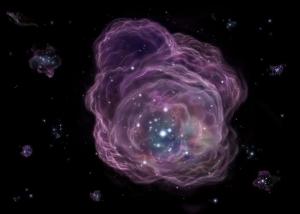Blog
Even Odds
22 August 2014
 National Astronomical Observatory of Japan
National Astronomical Observatory of JapanIn the early moments of the universe, hydrogen and helium were formed through a process known as baryogenesis. Trace amounts of other elements such as lithium were also produced, but none of the heavier elements. This means that the first generation of stars were composed of hydrogen and helium, and it is only through fusion in their cores that the heavier elements we see today were created. The carbon, oxygen and iron in our bodies was produced through that process, which is why it is often said that we are star stuff.
Because heavier elements are only produced in stellar interiors, one way we can determine the age of a star is by the amount of these elements in its atmosphere, what is known as its metallicity. Younger stars will tend to have a higher metallicity, since they tend to form from the dust of earlier stars. Because of this, there has been a great deal of effort to discover very low metallicity stars. We have found some stars with quite low metallicity, indicating that they are second generation stars.
There has also been a search for first generation stars, but this has not been successful. Many of these stars would likely have been quite large, and therefore would burn through its hydrogen rather quickly, dying in a tremendous supernova explosion. One of the unanswered questions about these first generation stars is just how large they could get. The larger a star is, the shorter its lifetime. The general consensus is that first generation stars could have been as large as 200 – 300 solar masses, but proving that is a challenge.
Now a new paper in Science has found evidence to support this idea.1 The team looked at a low metallicity star known as SDSS J0018-0939. It is a dim orange star that seems to be a second-generation star. They looked at the abundances of 18 different elements within the star’s spectrum, and found that elements with an even atomic number (such as titanium and nickel) are more abundant than elements with odd atomic numbers (such as scandium and cobalt). This suggests that its progenitor star had some dying mechanism to produce more even elements than odd.
But this is something you would expect to see in the death of supermassive stars. When very large first-generation stars had fused most of their hydrogen into helium in their cores, they would then collapse quickly under their own weight. This would trigger a very large supernova (hypernova) known as a pair-instability supernova. In such a supernova, the gamma rays produced by nuclear collision are so energetic that they decay into electrons and positrons. These interact less strongly with helium, allowing more helium nuclei to fuse to produce heavier elements. Since helium has an atomic number of 2, more even elements would be produced.
Simply finding higher even/odd element ratios in a single star isn’t enough to prove that first generation stars were quite large, but it does show that the idea is feasible. We’ll have to look at more second-generation stars to see if the idea truly holds up.
Aoki, W., et al. “A chemical signature of first-generation very massive stars.” Science 345.6199 (2014): 912-915. ↩︎